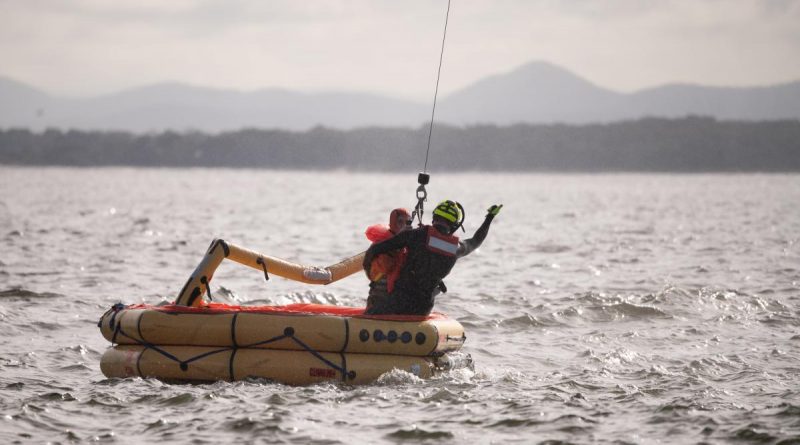Survival training gets real

A dramatic marine search and rescue effort at Nelson Bay looked nail-bitingly real, but was in fact a training exercise conducted by Air Force’s No. 2 Squadron to boost their survival continuation skills.
CAPTION: A member of Air Force’s No. 2 Squadron is winched from a life raft on Nelson Bay to a search and rescue helicopter during a survival training exercise. Story by Flight Lieutenant Claire Burnet. Photo by Lieutenant Samuel Hicks.
Ten aviators were given the opportunity to practise their survival knowledge with a series of simulated land and sea events conducted collaboratively by Air Force, Marine Rescue Port Stephens and CHC Helicopters Australia.

Exercise Damp Eagle simulated two aspects of survival continuation that may be experienced by Air Force aircrew.
At sea, the exercise gave aviators the chance to try out an inflatable eleven-person Winslow life raft, open-water marine rescue vessel and individual winching by a search and rescue helicopter.
On land, they sought higher ground by climbing Mount Tomaree to practise using heliographs, laser flares and giving rescue coordinates using radio communication.
No. 2 Squadron crew member, Flying Officer Harry O’Connor, said the exercise was a great insight into what aircrew might experience in a real-life search and rescue situation.
“It was my first time wearing an immersion suit and using a life raft in open water,” Flying Officer O’Connor said.
“The exercise highlighted the importance of donning the suit and staying warm when stranded in an ocean environment.”
Aviators were provided the opportunity to practise their radio signalling techniques for contacting civilian rescue services, then experienced what it’s like to be winched by a search and rescue helicopter.
“To maximise our range we climbed Mount Tomaree and practised using heliographs and laser flares to signal to aircrew stranded below and to the E-7A Wedgetail aircraft flying overhead,” Flying Officer O’Connor said.
Commanding Officer No. 2 Squadron, Wing Commander Warren Haynes, said training exercises like Damp Eagle give aviators the opportunity to put into practice their safety and survivability skills.
“Real-life training helps Air Force aviators epitomise the Defence values of service, courage, respect, integrity and excellence in everything they do,” Wing Commander Haynes said.
.
.

.
.





